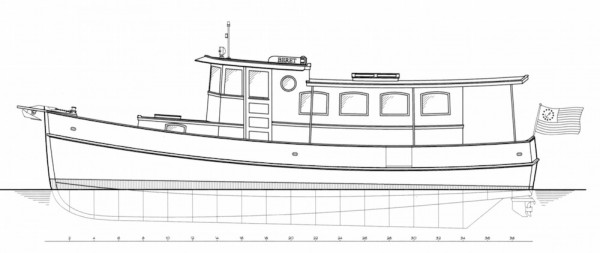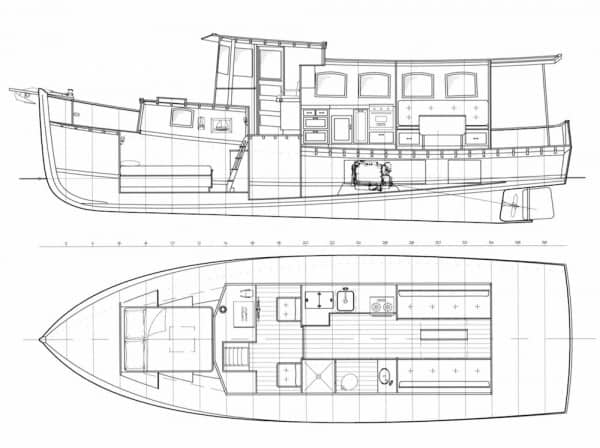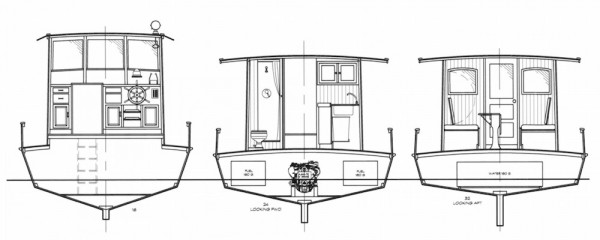Email This Page to a FriendBERET, A Low-Impact Coastal & River Cruiser by OCH Guide Doug Hylan
All Guide Posts » Blog
March 20, 2015
BERET is another in my “Hat” series – a line of powerboats that, for some unfathomable reason, are all named after hats. They have hard-chine hulls and, for ease of construction, are generally planked with sheet plywood. They are of the semi-displacement type, designed to use modern outboards for power, although most of them can be modified for inboard diesel propulsion. The series can trace its genome back to Harry Bryan’s inspired little Handy Billy design, and thence back to William Hand, who in the early 1900s pioneered the concept of chine-type hulls for powerboats.
I think that the semi-displacement hull form is the real sweet spot in the powerboat continuum. They popped up amazingly early in powerboat history, soon after people discovered that true displacement hull speed could indeed be defied and that, with more power, boats could be pushed at speeds beyond the classic 1.3 times the square root of their waterline length. They are most famously represented by the early Maine lobsterboats, but many Chesapeake deadrise boats would also qualify. Either of those as 36-footers, instead of topping out at a theoretical 1.3 x 6 = 7.8 knots, could do an easy 12. With rediculously big engines, both types have been pushed to plane at well over twice that speed in recent years, proving that, with sufficient applications of fossil fuels, anything can be made to go faster than it should.
The beauty of the semi-displacement type is that it can exceed hull speed but still operate perfectly well if slowed down to the displacement range. A true displacement hull will be slightly more efficient below hull speed, but as hull speed is approached, a good semi-displacement hull will be more efficient. It can then go on to about 2.5 times hull speed, with decreasing but still reasonable efficiency. These boats will handle beautifully at speeds between where a displacement boat is battling its bow wave and a planing boat is struggling to get out of it’s hole.
BERET is another of my “imaginary designs” which means that the plans are developed only enough to assure that the basic ideas will work, but I have not invested the serious time it takes to produce a set of working drawings. Like a young child’s “imaginary friend,” these designs have pretty much what I would want for my own purposes. So read on, and I’ll give you a short tour.
Now that my wife, Jean, and I are approaching some semblance of retirement, and Maine winters have lost some of their luster, thoughts are turning towards warm water cruising. BERET is aimed at roughly the same type of cruising as my last imaginary design, TUVA II, but is sized more for a couple than for a family. She would be “low impact” not just on the environment, but hopefully on her owner’s wallet as well, designed to run at a slightly more leisurely pace, and to be most comfortable in protected waters. Her hull is shallow and wide, much of it used for tankage, systems, and storage of the myriad junk that a life afloat seems to accumulate. Low freeboard allows easy boarding from dinghy or dock, and high bulwarks help keep grandparents and grandchildren onboard. Most of the accommodations are up on deck, making for grand viewing of the scenery, whether at anchor or underway.
The so-called trawler or tug configuration means that the pilothouse is high and placed well forward. This is not its best location for a good sea boat; in rough weather, everyone would be happier to be lower down and further aft, as in TUVA II, where there is less motion. On the plus side, there is a better view (more scenery, less foredeck) and easier docking and anchoring. On a questionable day, when TUVA II’s crew might vote for a fast dash “outside,” BERET’s skipper will likely opt to run inside on the waterway at a more moderate speed.
The drawings will likely be enough to explain most of the rest of BERET’s accommodations. Starting up forward, an honest-to-gosh double bed dominates the fo’c’s’le, and WalMart’s fitted sheets will work on it just fine. This is a real “master bedroom,” with space for all the clothing and linens required for long-term cruising. Face aft and climb the companionway ladder and you will enter the pilothouse with its large “dashboard” for spreading out charts, mugs of coffee and any meals you choose to take while underway. There are comfy seats for the captain and first mate and sliding doors port and starboard— handy for stepping out to handle lines or take videos of those dolphins playing in the bow wave.
Continuing aft, you step down to the main deck level where there is a spacious galley to starboard and a toilet room with separate shower to port. A few steps further aft brings you to the saloon. I’m a firm believer that many of the best times in cruising take place around a big drop-leaf table where a crowd can sit down to a convivial dinner and swap yarns. A symmetrical arrangement is more restful to the eye and brain, and that’s what we have here. The settee backs swing up to block off the side windows and expose generous berths when the saloon is used for bunking down the occasional overnight guests.
Slowing down is the primary way to give any boat a “low impact” status, but there are other aspects as well. To my mind, a gen-set increases the impact of any vessel: to the environment, to the pocket book, and to anyone anchored close by. Gen-sets must be about the most expensive way there is to create a kilowatt of electricity when the costs of purchase, installation, and maintenance are all added up. And to boot, they destroy the peace of idyllic anchorages, even if they’re equipped with the best mufflers money can buy. They are used mostly for servicing electric ranges; the most absurd of all marine appliances, but with air conditioning probably a close second.
You can easily forgo a gen-set and still enjoy all the conveniences it provides. A fuel cookstove is the first step. Natural gas, propane, butane, alcohol or diesel will all do the job. Next is a big battery bank and an inverter/charger to match. For charging, you will want either an oversize alternator on the propulsion engine, or a generous solar array, or both. All this may weigh a bit more than a gen-set, but it will cost far less. Fortunately, recent advances in lighting and refrigeration technology have made it possible to enjoy both of these comforts with minimal battery drain.
It wasn’t that long ago that we managed without air conditioning, so it’s worth looking at some old techniques for keeping cool. Everyone knows that using light-colored paint, and incorporating lots of ventilation is a must. BERET’s overhanging boat deck helps further by shading much of the cabin beneath it during the heat of the day, as well as making it possible to leave the side windows open during most rain showers.
I have shown both an inboard diesel and twin outboards for powering BERET. Each has its advantages. Twin outboards offer the gift of very quiet operation as well as low initial cost; they also offer simple and fast replacement, enhanced maneuverability, reduced draft, and increased reliability by virtue of their redundancy. An inboard diesel, however, can generate domestic hot water and drive an oversize generator. The theoretically-lower operating cost of a diesel is offset by its high initial cost, and the fact that diesel fuel now sells at a premium. The longevity and reliability of outboard motors increase with each model year, while modern lightweight, high-rpm diesels are losing ground on this front.
BERET’s hull is designed for plywood construction, using two layers of 1/2” material. This type of construction is fast and easy for the amateur builder, and makes it possible to use a non-developable bottom panel shape. Fiberglass or Dynel sheathing will reduce maintenance and make her immune to ship worms. The inherent stability of the beamy, chine-type hull will offset the height and weight of her superstructure, and her shallow draft will open lots of secluded anchorages that are off limits to deeper boats. With twin 60 hp outboard motors, she should have a top speed of about 12 knots, and cruise comfortably at 10. At eight knots, she will consume only about 3.5 gallons per hour.
Doug Hylan
Also appears in: In the Shop
Comments, Thoughts or Suggestions?
You can leave a comment or question for OCH and members below. Here are the comments so far…




